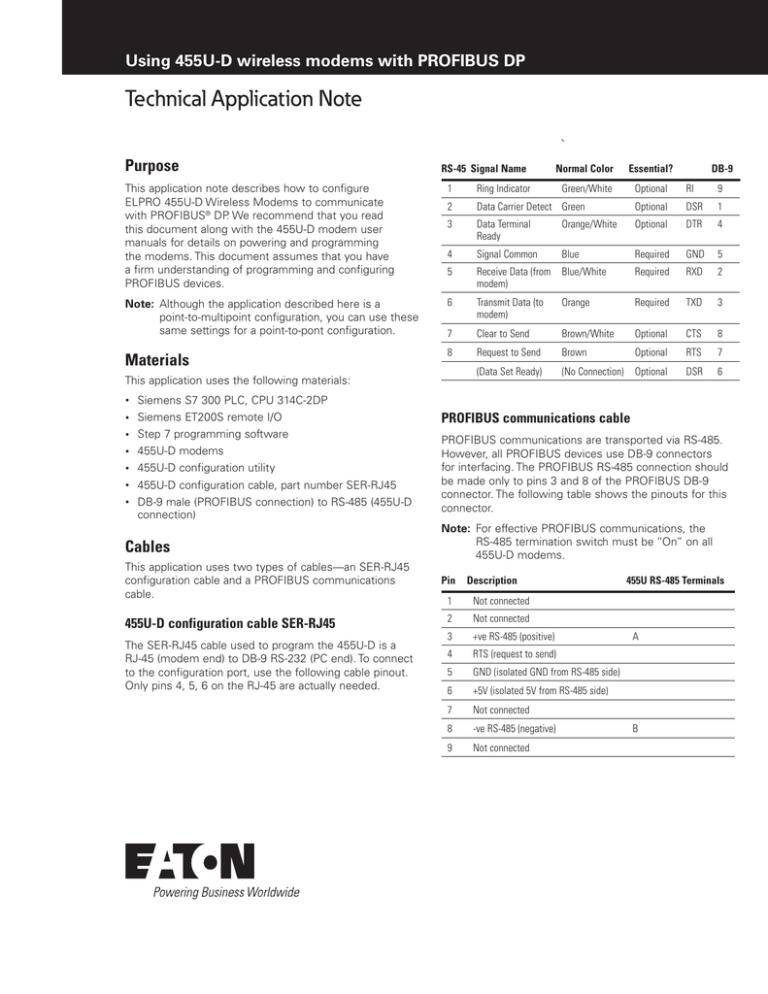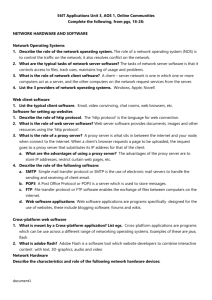
Using 455U-D wireless modems with PROFIBUS DP
Technical Application Note
Purpose
RS‑45 Signal Name
Normal Color
Essential?
Green/White
DB‑9
This application note describes how to configure
ELPRO 455U‑D Wireless Modems to communicate
with PROFIBUS® DP. We recommend that you read
this document along with the 455U-D modem user
manuals for details on powering and programming
the modems. This document assumes that you have
a firm understanding of programming and configuring
PROFIBUS devices.
1
Ring Indicator
Optional
RI
9
2
Data Carrier Detect Green
Optional
DSR
1
3
Data Terminal
Ready
Orange/White
Optional
DTR
4
4
Signal Common
Blue
Required
GND
5
5
Receive Data (from
modem)
Blue/White
Required
RXD
2
NNote: Although the application described here is a
point‑to‑multipoint configuration, you can use these
same settings for a point‑to‑pont configuration.
6
Transmit Data (to
modem)
Orange
Required
TXD
3
7
Clear to Send
Brown/White
Optional
CTS
8
Materials
8
Request to Send
Brown
Optional
RTS
7
(Data Set Ready)
(No Connection)
Optional
DSR
6
This application uses the following materials:
•
•
•
•
•
•
•
Siemens S7 300 PLC, CPU 314C-2DP
Siemens ET200S remote I/O
Step 7 programming software
455U-D modems
455U-D configuration utility
455U-D configuration cable, part number SER-RJ45
DB‑9 male (PROFIBUS connection) to RS‑485 (455U-D
connection)
Cables
This application uses two types of cables—an SER-RJ45
configuration cable and a PROFIBUS communications
cable.
455U-D configuration cable SER-RJ45
The SER-RJ45 cable used to program the 455U-D is a
RJ‑45 (modem end) to DB‑9 RS‑232 (PC end). To connect
to the configuration port, use the following cable pinout.
Only pins 4, 5, 6 on the RJ‑45 are actually needed.
PROFIBUS communications cable
PROFIBUS communications are transported via RS‑485.
However, all PROFIBUS devices use DB‑9 connectors
for interfacing. The PROFIBUS RS‑485 connection should
be made only to pins 3 and 8 of the PROFIBUS DB‑9
connector. The following table shows the pinouts for this
connector.
NNote: For effective PROFIBUS communications, the
RS‑485 termination switch must be “On” on all
455U-D modems.
Pin
Description
1
Not connected
2
Not connected
3
+ve RS‑485 (positive)
4
RTS (request to send)
5
GND (isolated GND from RS‑485 side)
6
+5V (isolated 5V from RS‑485 side)
7
Not connected
8
-ve RS‑485 (negative)
9
Not connected
455U RS‑485 Terminals
A
B
Power connections
Configuring 455U-D modems
The 455U-D module is powered by either a 12–15 Vdc
supply or 15–28 Vdc supply, minimum 24W capacity. The
12–15V supply may be used to charge a backup battery
(12V lead-acid) when the main supply is available. In the
event of a main supply failure, the module automatically
changes over to run from the backup battery.
You can configure the modem using the 455U configuration
utility or via Hayes commands using a terminal package
such as ProComm or HyperTerminal. The following is a brief
overview of the settings needed. Refer to the modem user
manual for more information on addressing formats.
For DC supplies, the negative side of the supply is
connected to ground. The supply negative is connected to
the module case internally. The positive side of the supply
must not be connected to ground. The DC supply may be a
floating supply or negatively grounded.
The following screen shows configuration settings for the
modem located at the PROFIBUS master location.
System address is the same
for all modems
Unit address is different
for each modem
The power requirements of the 455U-D units is 90 mA
at 12 Vdc when quiescent, and 2A at 12 Vdc (5W) when
transmitting.
B
A
RS-485
+24 +12 DIO
SUPPLY
-
B A
+
12–15 Vdc
RS‑485 path is for the address that the message is sent to.
128 is the broadcast address for RS‑485
12–15 Vdc Power Supply
The following screen shows configuration settings for all
remote modems.
B
A
RS-485
+24 +12 DIO
SUPPLY
B A
+ Optional
13.8V lead
- acid backup
-
+
battery
15–28V
15–28 Vdc Power Supply
Select this check box
when using the
broadcast feature on all
remote slave modems
2
Technical Application Note
September 2014 www.eaton.com
RS‑485 path address 129 indicates
that all messages will return to unit
address 1
Radio tab—make sure that all modems radio
settings are at 9600 baud
S 18...26 tab—set Lead-In tone time to 7
RS‑485 tab—make sure that all modems are set to
the following format (note that parity is even)
S 27...35 tab—set Transmitter Hold-Up Time to 0
Technical Application Note
September 2014 www.eaton.com
3
You can also configure the modems by using a terminal
package and entering the associated AT commands. You
may need to use this method if the 455U-D configuration
utility is not available. Refer to the modem user manual for
all register definitions.
2. Adjust the bus parameters to match the following
screen:
•
•
•
Note the following:
•
•
ATS26 Radio Lead-In Tone Time must be set to 7. (Default 10)
•
•
ATS27 Transmitter Hold-Up Time must be set to 0 (Default 60)
•
•
&Z3 = 128 (broadcast to all remote units) must be set at
Master Modem
•
&Z3 = 129 (return path for all remote modems to unit
address 1) must be set at all remote modems
•
•
•
Tslot_Init: 16383
Max Tsdr: 1023
Min Tsdr: 11
Tset: 494
Tgui: 0
Gap Factor: 10
Retry limit: 1
Ttr: 216187
Watchdog: 413004
The following example shows the full configuration of the
455U-D using the AT command set.
OK
at&v
B3 C7 E1 Q0 V1 X1 &B0 &C1 &D0 &E0 \C6 \N1 \P0 &K0
&L1 &M0 &N1 &U1 \K0 \T60
#A0 #E0 &A4 R5 #O0 &H0 &R0
FT=460.0000 (450.0000-470.0000) FR=460.0000
(450.0000-470.0000)
S0:0 S1:3 S2:43 S3:13 S4:10 S5:8 S6:0 S7:5 S8:0 S9:78
S10:3 S11:0 S12:0
S13:1 S14:50 S15:0 S16:0 S17:0 S18:0 S19:2 S20:0 S21:0
S22:0 S23:0 S24:0
S25:100 S26:7 S27:0 S28:0 S29:0 S30:5 S31:8 S32:71
S33:0 S34:133 S35:141
&Z0=
&Z1=
&Z2=
&Z3=128
3. Download the new settings to the PLC and restart it
with the modems connected.
Configuring a Siemens S7 300 PLC
1. Set the transmission rate to 9.6 kpbs and set the profile
to User-Defined. Then, click Bus Parameters.
4. Make sure to use the correct cable between the
PROFIBUS devices and 455U-D modem, as described
earlier in ”Cables.”
5. When testing, ensure that the signal levels are within
an acceptable range so that signals are not too strong
or too weak, providing false indications.
During testing, you can the check signal strength levels
via the configuration port using a terminal package. The
serial settings are 9600, 8, N, 1.
Enter command at&t5 (RSSI measurement) and
monitor the rolling average. Signal detect specifications
for the 455U-D are –120 to –60 dBm.
at&t5
Signal Strength Display
This Sample
Rolling Average
Min Max
Min Max
–109 dBm –099 dBm –113 dBm –075 dBm
In the example above, the last line shows the noise
floor RSSI level.
4
Technical Application Note
September 2014 www.eaton.com
Eaton’s wireless business
www.eaton.com/wireless
North America & Latin America
5735 W. Las Positas Suite 100
Pleasanton, CA 94588
United States
Telephone: +1 925 924 8500
Australia, New Zealand
9/12 Billabong Street
Stafford Queensland 4053
Australia
Telephone: +61 7 3352 8600
Southeast Asia
2 Serangoon North Avenue 5
# 06-01 Fu Yu Building, 554911
Singapore
Telephone: +65 6645 9888
Europe
Hein-Moeller-Straße 7-11
53115 Bonn, Germany
Telephone: +49 228 602 5573
China
955 Shengli Road
East Area of Zhangjiang High-Tech Park
Shanghai, 201201
China
Telephone: +86 21 2899 3600
Eaton
1000 Eaton Boulevard
Cleveland, OH 44122
United States
Eaton.com
© 2014 Eaton
All Rights Reserved
Printed in USA
September 2014
Eaton is a registered trademark.
All other trademarks are property
of their respective owners.




